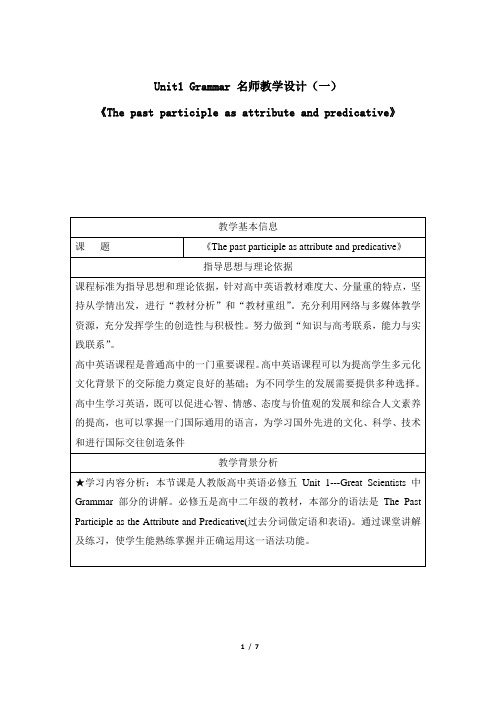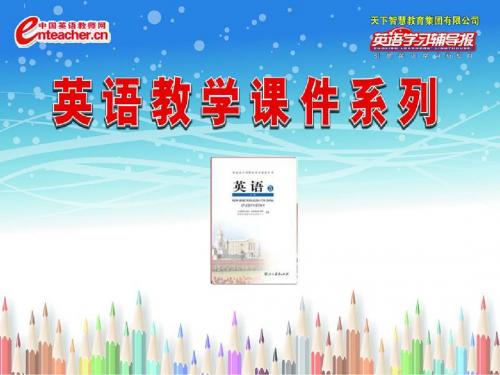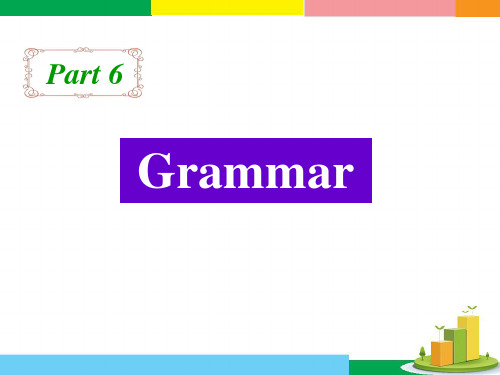新人教版必修五Unit1GrammarandUsefulStructures教案word精品文档3页
- 格式:doc
- 大小:26.50 KB
- 文档页数:3




Unit 1 Teenage LifePeriod 3 Discovering Useful Structures 教材分析该板块的活动主题为“润色文稿”(Improve a draft),目标语法知识是名词短语、形容词短语和副词短语的用法。
学生在熟练掌握名词短语、形容词短语和副词短语的形式和意义后,能够将其运用到语篇中,使语言表达更加充实、生动和准确。
教学目标1. 能正确理解使用下列词汇:category, function, noun phrase, adjective phrase, adverb phrase。
2. 能够理解并正确运用名词短语、形容词短语和副词短语。
3. 能通过使用名词短语、形容词短语和副词短语润色语言表达,使其更加充实、生动和准确。
教学重难点【教学重点】帮助学生在语篇中理解并运用名词短语、形容词短语和副词短语,丰富语篇表达内容,提高语篇质量。
【教学难点】引导学生熟练掌握名词短语、形容词短语和副词短语的形式和意义。
教学过程Task Improve a draftStep 1 Warming-upRead the poem aloud and see how the underlined parts work in the poem: Nothing so rareAs a day in June,The air so fineAnd the blossoms all blue....Its beautiful melodyFloats like a balloon.Step 2 Observing1. Work on Activity 1. Students find and mark the noun/ adjective/ adverb phrases in the following sentences:(1) The first week was a little confusing.(2) The building is so big that I’m completely lost.(3) The kids over there are putting something on a round paper plate....2.Students observe the sentences again and state the phrases’ functions.设计意图:该环节让学生通过观察例句,发现句子中的目标短语结构,进一步感知其在语言表达中所起到的作用。


Unit 1 Great ScientistsVocabulary and Useful ExpressionTeaching Aims:1.Learn expressions & phrasesnguage pointsDifficult and Important Points:1)Language points2)The usage of “suggest & in addition”Teaching Methods:Presentation & PracticeTeaching Procedures:Step I RevisionHave a dictationStep II. Check the answersCheck the answers of yesterday’s homework (ing Words and Expressions)Step III. Expressions & phrasesExpressions & phrases (1)1.know about… 了解……的情况2.lift up 举起;抬起;提升3.steam engine 蒸汽机4.physical characteristic 人体的特征5.put forward a theory about black holes提出一个有关黑洞的理论6. infectious disease 传染性的疾病7. in scientific research 在科学研究上8. examine a new scientific idea 验证一个新的科学思想9. draw a conclusion 得出结论10. analyze the results 分析结果11. a well-known doctor 一个著名的医生12. ordinary people 百姓;普通人13. expose (…)to sth. 暴露(…..)在……中14. the most deadly disease 最致命的疾病15. terrified people 被吓坏的人们16. get interested in sth./doing sth. 对…产生兴趣17. absorb sth. into… 把….吸收入….18. gather the information 收集信息19. determine to do sth. 决心干某事20. a valuable clue 一条珍贵的线索21. the water pump 水泵22. in addition (to…) 除..…之外还有…23. link … to … 将….和….联系起来(be linked to…)24. have it delivered (have sth. done) 叫某人送东西25. die of… 死于…26. announce with certainty 肯定地宣布27. polluted water 被污染的水28. prevent sb. from doing sth. 阻止某人干某事29. deal with… 处理……30. solve the problem 解决难题Expressions & Phrases (2)e to an end 到了尽头2.find the cause of this illness 找出疾病的起因3.look into… 调查……4.apart from… 除…..之外;此外(=except for…)5.prepare for… 预备好….6.be strict with sb. 对某人严格要求7.a revolutionary theory 一个革命性的理论8.lead to… 通向…. ;导致… (注意:to为介词)9.make sense 有意义10. at times =sometimes 有时候11. contribute to sth. 有助于;促进12. encourage sb. to do sth. 鼓励某人做某事13. point of view 观点14. living conditions 居住条件15. break… in/into pieces 把…摔成碎块16. be devoted to sth./sb. 专致于…….; 关心…;挚爱…17. devote one’s life to doing sth. 献身于…..18. curved line 曲线19. achieve great success 取得巨大的成功Step nguage Points1.discover & inventdiscover v. “ 发现” 被探索或被揭示的事物早已客观存在着.Columbus discovered America in 1492.哥伦布于1492年发现了美洲.Who discovered radium? 谁发现了镭?invent v. “发明”,指的是发明原先不存在的东西.Who invented the steam engine? 谁发明了蒸汽机?2.who invented the way of giving electricity to everybody in large cities?是谁发明了把电带给大城市中的每个人的办法?the way of doing sth.= the way to do sth … “做…..的方法”She showed us the way of cleaning it.= She showed us the way to clean it.她教给我们清洗它的办法.the way引导的定语从句的引导词有三种, 可以用that;可以用in which;还可以省略.I don’t l ike the way (that / in which) you speak to your father.我不喜欢你跟你父亲讲话的方式.与way相关的短语:by the way 顺便说、by way of … 通过……的方法,经,由lose one’s way 迷路no way (俚语) 没门,别想feel one’s way 摸黑走,谨慎从事on one’s way to…在去…的路上in this way=by this means=with this method用这种方法3.Who put forward a theory about black holes?谁提出了黑洞的理论?put forward(1) to offer (an idea, suggestion etc.) for consideration 提出(建议等)(2)推荐某人或自己任职位;提名May I put your name forward as our monitor?我能否提名你当我们的班长?put away 抛弃;舍弃put down 写下来;记入名单;put on 穿上;戴上;增加put off 耽误;延期put out 熄灭(灯);扑灭(火) put up 建立;建造put up with… 忍受……•You can take anything from the shelf and read, but please ______ the books when you’ve finished with them.A. put onB. put downC. put backD. put off4.This was the most deadly disease of its day.die (v.) dead (adj.) death (n.)deadlyadj. (1).dangerous; likely to cause death 危险的;致命的a deadly disease/weapon(2). highly effective against sth. or sb不强有力的;致命的a deadly remark 击中要害的评论(3)aiming to kill or destroy意在杀死的;不共戴天的:a deadly enemy不共戴天的敌人adv. (1). Very极度;非常;十分: deadly serious 十分认真(2). like death 死一般地: deadly pale 死一般苍白5.But he became inspired when he thought about helping ordinary people exposed to cholera. expose在句中是过去分词作后置定语,表示被动.意为“患霍乱的”.如:The book written by Luxun is very popular.expose v.(1)to make visible 暴露“expose ….to….”He exposes his skin to the sun. 他把皮肤暴露在阳光下.(2)to reveal the guilt or wrong doing of …揭露;揭发He exposed their plot.他揭穿了他们的阴谋.I threatened to expose him ( to the police).我威胁要(向警察)揭发他.expose to 使易受,使受expose a fraud 揭穿骗局expose sth. to the light of day 把某事暴露于光天化日之下6. So many thousands of terrified people died every time there was an outbreak.每次爆发霍乱时就有大批惊慌的老百姓病死.every time是连词,引导时间状语从句,意为“每次,每当”,如:Every time I meet him, I always think of the things happened between us.每次见到他,我就想起发生在我们之间的事情.immediately, the moment, directly, instantly 等都可以作连词,引导时间状语从句,意为“一……就……”,如:I will give the letter to him immediately I see him.我一见到他就把这封信给他.I came directly I got your letter.我一接到你的信就来了.7.The first suggested that cholera multiplied in the air without reason.第一种看法是霍乱病毒在空气中无缘无故地繁殖着.(Suggest 用法参考P43.4,并完成相关的练习)8.absorb v. 吸收(液体);承受;承担(费用等)Use the cloth to absorb the spilled ink. 吸干撒的墨水We will not absorb these charges.我们不能承担这些费用.absorb…in/by..吸引.注意I was absorbed in a book and didn’t hear you call.专心看书absorb…into…吸收…The big company has gradually absorbed these small companies into its own organization.这家大公司逐渐将这些小的公司吞并了。
Unit1 Grammar 优教教学设计(一)设计意图This is the last period of this unit, aiming to help students get a basic knowledge of the grammar in this unit. The emphasis of this period is mainly placed on understanding and usage of the grammar. Therefore, teachers should create a relatively real context to present enough sentences for students to draw a conclusion about the rule of the Past Participle. In the meantime teachers should offer more opportunities for students to practice. Exercises designed ought to be simple and easy to operate, which are connected with their daily life to make it easy to understand.教学目标1. To help students learn to use the Past Participle as the predicative and attribute.2. To learn to use the Past Participle in the real situation through self-study and practice.3. To help students be absorbed in English study and enjoy the beauty of English.教学重点Enable students to master the usage of the Past Participle.教学难点To guide students to know how to use the Past Participle in the real situation.教学过程Step 1: Lead-in(设计意图:通过课文句子导入新课,让学生在语境中体会情态动词,同时带着问题进入课堂,激发学生兴趣。
Unit 1 Great Scientists
Grammar and Useful Structures
Teaching Aims:
1.Teach grammar (The Past Participle as the Predicative &
Attribute)
2.Improve the students’ listening skills.
Difficult and Important Points:
1)Learn the grammar(The Past Participle as the Predicative & Attribute)
2)Have the Ss sum up the function of the past participle using inductive method.
Teaching Methods:
1.Inductive Method
2.Group work
Teaching Procedures:
Step I Dictation
Step II. Grammar
1.Please look at the sentences carefully. Pick out the attribute& predicative of the sentences.
1) I was angry with him for keeping me waiting so long.
2) She is a beautiful young lady.
3) He got worried about losing the money.
第 1 页
第 2 页 4) Sally was so excited at the good news.
5) So many thousands of terrified people died.
2.Please classify the words that you identify into groups and explain why you divide them into these groups.
angry beautiful young
worried excited terrified
3. Now use a different past participle/adjective in each sentence to change the mood of the sentence.
4. Discovering Useful Structures P4
(1).Find more examples in the reading passage where the past participle is used as attribute and predicative.1) Doctor John Snow was a well-known doctor in London. (Attribute)
2) John Snow told the astonished people in Broad Street. (Attribute)
3) He got interested in the two theories.(predicative)
4) Neither its cause, nor its cure was understood . (Predicative)
(2). Complete the table with phrases that have the same meaning
Step III. Listening P5 Using language
Step IV. Discussion In pairs discuss what scientific job each of you would like to choose
in the future. (Refer to the questions &expressions on P6 that may help you) 10.an animal that is trapped
10.a trapped animal 9.the audience who feel tired 9.the tired audience
8.a door that is closed 8.a closed door
7.a vase that is broken 7.a broken vase
6.children who look astonished
6. astonished children 5.a winner that is pleased 5. a pleased winner 4.a room that is crowded
4.a crowded room 3.water that is polluted
3.polluted water 2.seats that are reserved 2.reserved seats 1.people who are terrified 1.terrified people Past Participle as the Predicative Past Participle as the
Step V. Exercises
•Finish Ex. 2 on P42. (Translation)
•Finish Ex.1&2 on P44.(Using structures)
Step VI. Summary
Step VII. Homework assignment
希望以上资料对你有所帮助,附励志名言3条::
1、世事忙忙如水流,休将名利挂心头。
粗茶淡饭随缘过,富贵荣华莫强求。
2、“我欲”是贫穷的标志。
事能常足,心常惬,人到无求品自高。
3、人生至恶是善谈人过;人生至愚恶闻己过。
第 3 页。